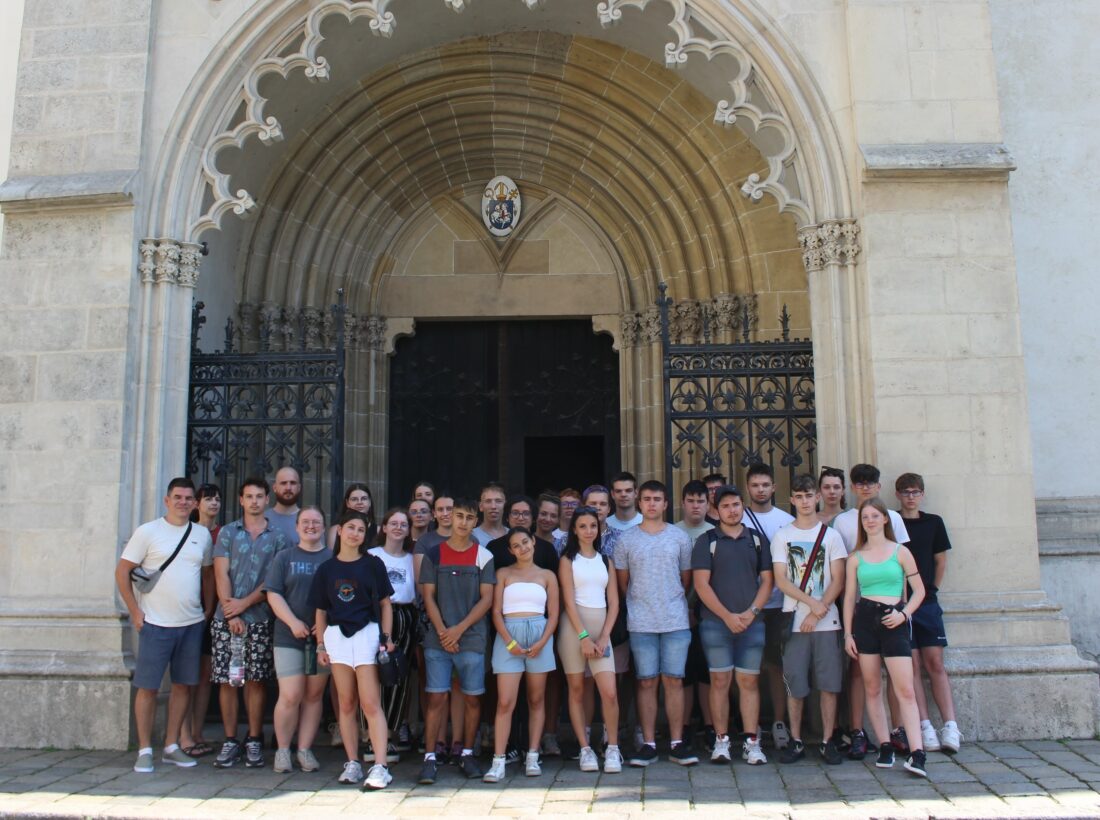
History and Ethnography camp in Slovakia
The Nagybajom 2 and Jászberény 3 groups’ summer thematic camp was the Historical and Cultural Camp in Slovakia. Having arrived early in the afternoon, our first stop was Bratislava. The city’s history has been influenced by many nations, as it was the coronation site and capital of the Kingdom of Hungary between the 16th and 19th centuries. Thus, it played a very important role in our country’s history. Approaching the city, the building block of the four-towered castle stands out from afar. The depiction of the castle appears on Slovak euro coins as well.
After getting off the bus, we met local historian Mihály Brogyányi, who was our guide for the week. During our short city walk, we saw St. Martin’s Cathedral, the Gothic coronation church under the castle, with a replica of the Holy Crown on its high tower. Through Michael’s Gate, the only remaining gate of the old town, we walked past several palaces in the small streets branching off the main square. Due to the great heat, we had to rest several times in shady spots. We also took a look inside St. Nicholas Church, where, after a few minutes of rest and prayer, we continued our journey.
Leaving Bratislava, our destination was Devín Castle, which protected the former Hungarian border from the west. The castle is located at the confluence of the Danube and Morava rivers, and from its peak, an incredible panorama unfolded before us.
The next days, we visited historically significant towns such as Nitra, Banská Štiavnica, Trnava, Trenčín, and Bojnice.
Our experiences from the historical places visited last week:
“In Csallóköz, our journey led us to Nitra Castle and the Gútia watermill. Csallóköz is the largest inland island in Europe, a long river island in the Slovak part of the Little Hungarian Plain, north of the Danube, southeast of Bratislava. Until 1918, it was an integral part of the Kingdom of Hungary, divided between Pozsony and Komárom counties. Despite the relocations in the second half of the 1940s, the population is still predominantly Hungarian. Previously, the milling industry based on the rivers was significant. We visited the watermill in Gúta, crossing Europe’s longest covered wooden bridge. Before Nitra Castle, we had the opportunity to see the Kluch Palace, decorated with an Atlas statue, the County Hall, and the Plague Column, the largest statue group in the town. It was built in 1750 by the order of Bishop Esterházy. The religious statue group was designed and built by Martin Vogler. In the castle, we visited St. Emmeram’s Cathedral, which burned down in the second half of the 13th century and was later rebuilt in the Baroque style after the destructions by Matthew Csák between 1333-1335. The church has three parts: a Romanesque, original Gothic and a lower church. The interior frescoes were painted by Italian masters.
My favorite was the Thursday tour when we were in Trnava and Trenčín. We saw two churches in the “Slovak Rome” and heard a story about the city’s biggest disaster. In Trenčín, we learned about the castle’s history, numerous legends, and finally climbed the tower of the former petty king, Matthew Csák.”
Boglárka Szalai, Nagybajom 2
“Visiting the Modra Majolica Manufactory:
That is, we learned how ceramics are made under the hands of the Habán masters. A lump of clay that quickly ends up on the table. Well, it’s not that easy. The masters first cover their vessels with tin glaze, then later paint them with unique patterns and colors, passed down from generation to generation, each with different meanings. After the raw clay works are finished, they are fired at nearly 1000 degrees Celsius, then dipped in glaze (a vitrifying substance) and fired again. This is followed by drawing the patterns, and then the third and fourth firings, which give the final color. It’s amazing to see how many meticulous processes turn clay into a beautiful finished product. Moreover, did you know that the originally green paint only gets its true color after firing? Until then, it appears black, and that’s how they work with it.
After visiting the manufactory, our journey led to the Driny Cave, discovered in 1930. Narrow paths, wonderful sights, and occasionally trickling water. The dripstone cave boasts stunning stalactite decorations. Its unique formations include the lace-edged “Elephant Ears.”
After the cool cave, we continued our journey on the sunlit surface. We conquered the Red Stone Castle, where our guide informed us with many exciting legends and interesting facts during the castle tour. The castle was part of Hungary’s western defense line. In the 16th century, Miklós Pálffy, the most successful Turkish defeater, received the castle as a dowry and purchased the part above the dowry from the Fugger family. The Pálffy family owned the estate until the nationalization in 1945. According to legend, fairies chose the location for the castle, so malevolent spirits no longer harm it, and in gratitude, it remains one of the best-preserved fortresses in the Lesser Carpathians.”
Vajda Milán – Nagybajom 2
“The Mining Museum in Banská Štiavnica was particularly interesting to me because the subject somewhat fascinates me. After putting on the cloak and helmet, we felt like real miners. We only visited the first two levels of the mine, but we saw many interesting things. From the initial tools and passages to the machines of the modern age, we could admire it all. We saw what a great task it was to eliminate water and the impressive achievements they used to do so. We also observed how narrow the medieval passages were and that they were excavated by hand, which meant an annual progress of 12 meters. It made me think about how hard and difficult mining work was in the past and how much effort was required to create a small tunnel. Getting to know the town was also a great experience for us!”
Oláh András Mihály – Jászberény 3
“Starting our adventure today, we visited several churches in Trnava, each more beautiful than the last. The image of the Virgin Mary impressed me the most; everyone listened in awe to the legend of the Weeping Virgin. After this, we visited Trenčín, where we admired the castle with great wonder. The Gothic buildings dazzled the whole group, including us. The steep, monumental building was not easy to approach, as it was quite high up. At the castle, we tested our endurance by climbing to the lookout tower. However, it was well worth it, as a breathtaking view unfolded before our eyes. The panorama was wonderful. After this, we received our reward by tasting the best ice cream in the country. Then we traveled to our accommodation, where we could rest from the eventful day. During our usual evening walk, we climbed up to a giant bench. Once again, we were pleasantly tired!”
Varga Orsolya and Tilda Tamasi – Jászberény 3
“After breakfast, we took a bus to visit Bojnice Castle, located on the banks of the Nitra River. The castle was built in the 13th century and was transformed into a luxurious mansion at the end of the 19th century when Count János Ferenc Pálffy commissioned József Hubert, a renowned architect from Budapest, to redesign it in the style of Gothic French interiors. In front of the castle stands a roughly 700-year-old lime tree, planted by Matthew III Csák, and it is believed that King Matthias himself cooled off in its shade and held a national assembly here. The castle boasts numerous impressive rooms, such as the Winter Garden and the Gallery, but the most splendid ones were the Eastern Room, the Chapel, and the Golden Room. The Eastern Room was built entirely in an Eastern style and served as János Pálffy’s study. The Golden Room got its name from its ceiling, which is covered with pure gold; in the center of the ceiling, we saw the inscription “Omnia cum tempore,” which means “everything in its own time.” Looking down into the castle well, we caught a glimpse of the castle cave, which we later entered.”
Rutai Gergely – Szeged 3 – assistant mentor
We thank everyone who contributed to and assisted with this wonderful trip!


